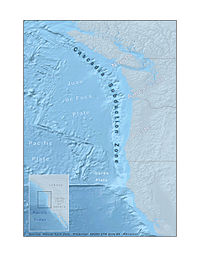
Photo from wikipedia
This article develops global models of damping scaling factors (DSFs) for subduction zone earthquakes that are functions of the damping ratio, spectral period, earthquake magnitude, and distance. The Next Generation… Click to show full abstract
This article develops global models of damping scaling factors (DSFs) for subduction zone earthquakes that are functions of the damping ratio, spectral period, earthquake magnitude, and distance. The Next Generation Attenuation for subduction earthquakes (NGA-Sub) project has developed the largest uniformly processed database of recorded ground motions to date from seven subduction regions: Alaska, Cascadia, Central America and Mexico, South America, Japan, Taiwan, and New Zealand. NGA-Sub used this database to develop new ground motion models (GMMs) at a reference 5% damping ratio. We worked with the NGA-Sub project team to develop an extended database that includes pseudo-spectral accelerations (PSA) for 11 damping ratios between 0.5% and 30%. We use this database to develop parametric models of DSF for both interface and intraslab subduction earthquakes that can be used to adjust any subduction GMM from a reference 5% damping ratio to other damping ratios. The DSF is strongly influenced by the response spectral shape and the duration of motion; therefore, in addition to the damping ratio, the median DSF model uses spectral period, magnitude, and distance as surrogate predictor variables to capture the effects of the spectral shape and the duration of motion. We also develop parametric models for the standard deviation of DSF. The models presented in this article are for the RotD50 horizontal component of PSA and are compared with the models for shallow crustal earthquakes in active tectonic regions. Some noticeable differences arise from the considerably longer duration of interface records for very large magnitude events and the enriched high-frequency content of intraslab records, compared with shallow crustal earthquakes. Regional differences are discussed by comparing the proposed global models with the data from each subduction region along with recommendations on the applicability of the models.
Journal Title: Earthquake Spectra
Year Published: 2021
Link to full text (if available)
Share on Social Media: Sign Up to like & get
recommendations!